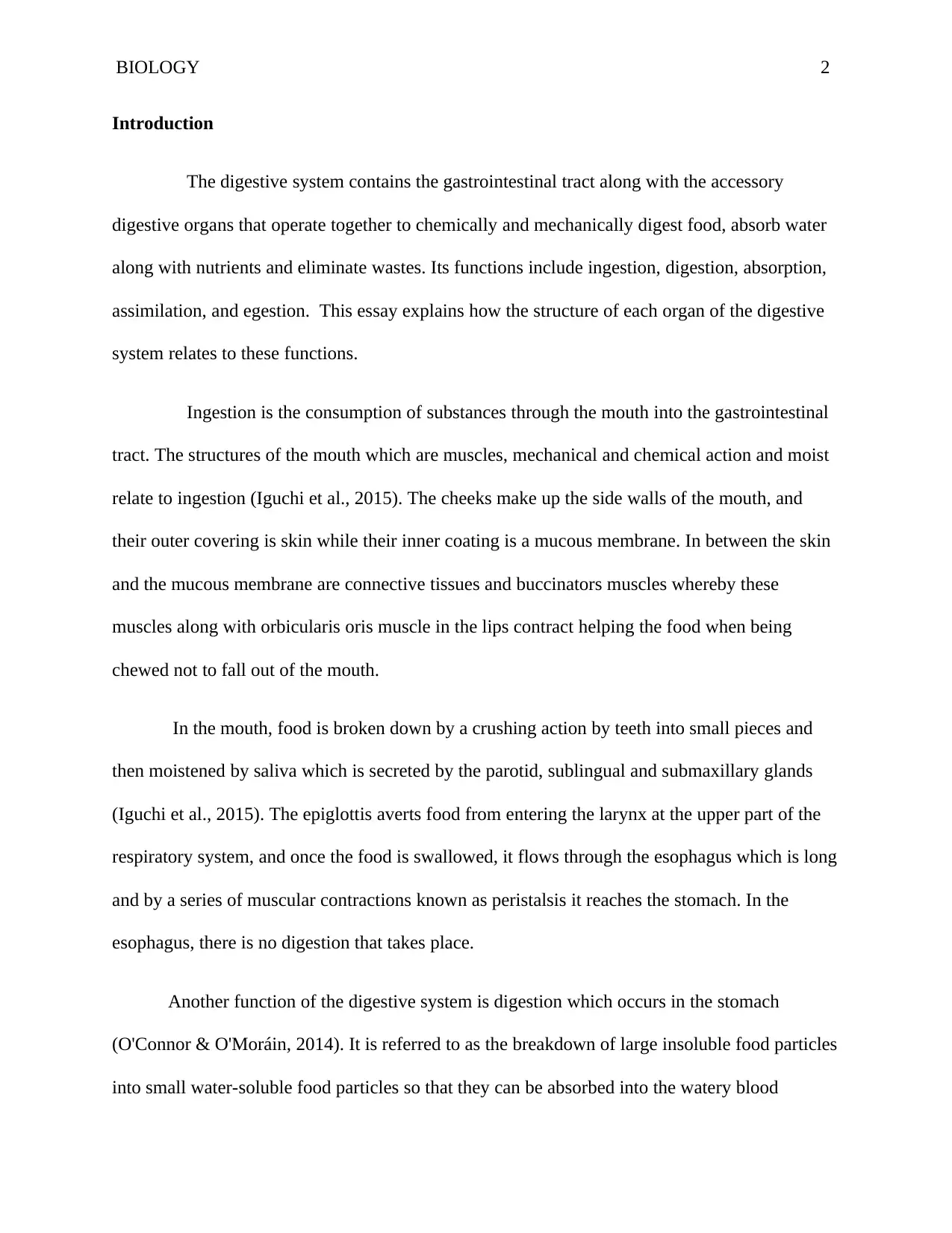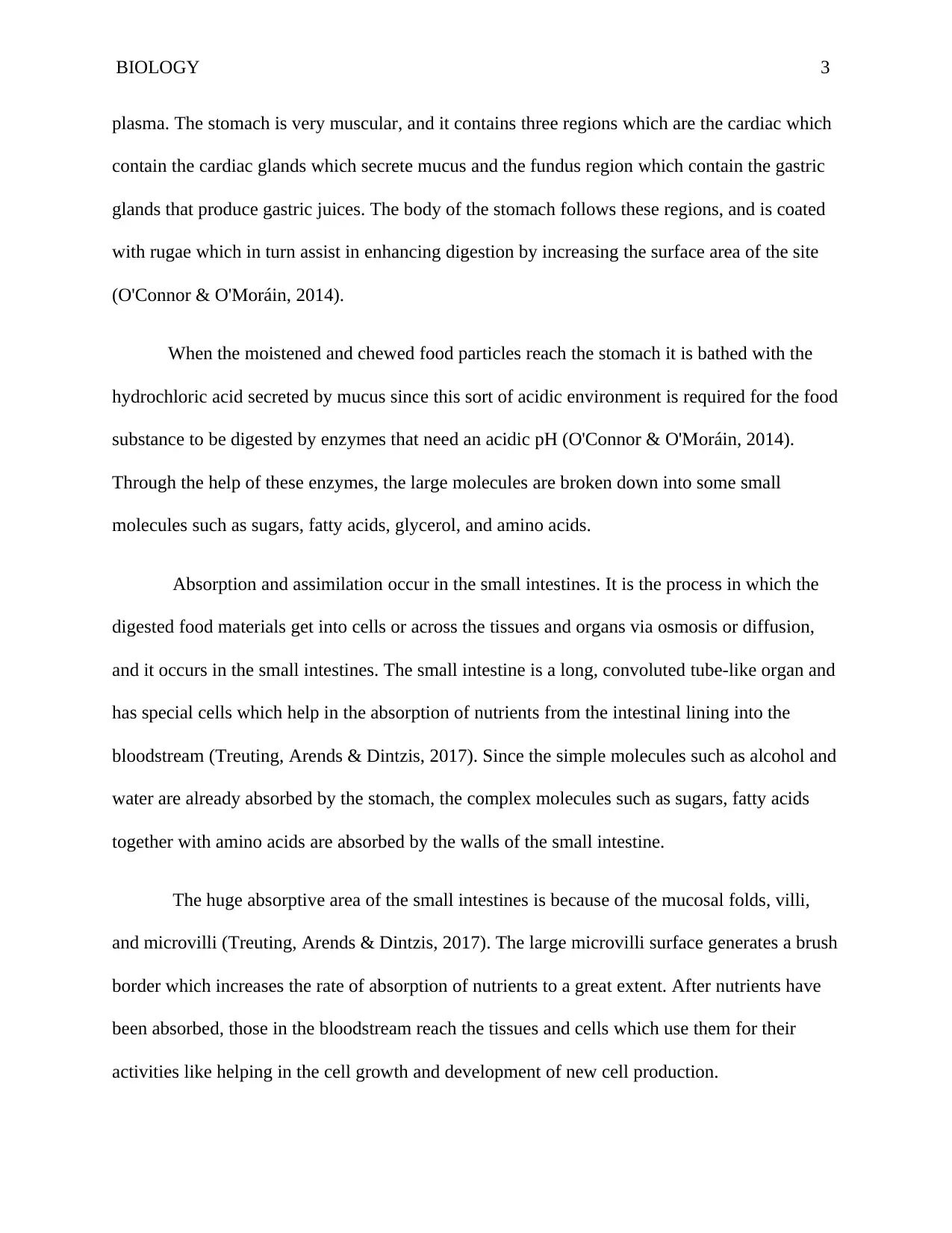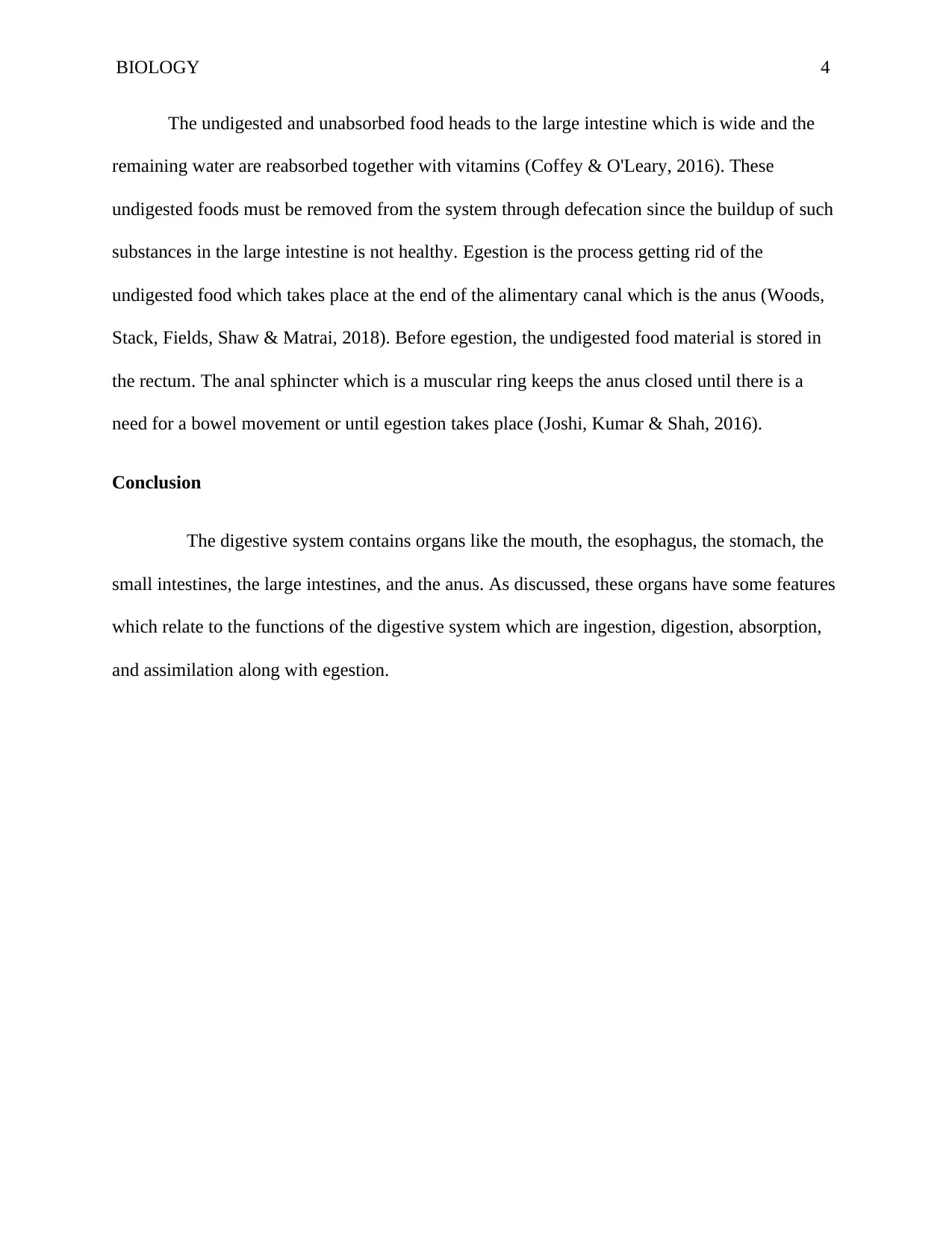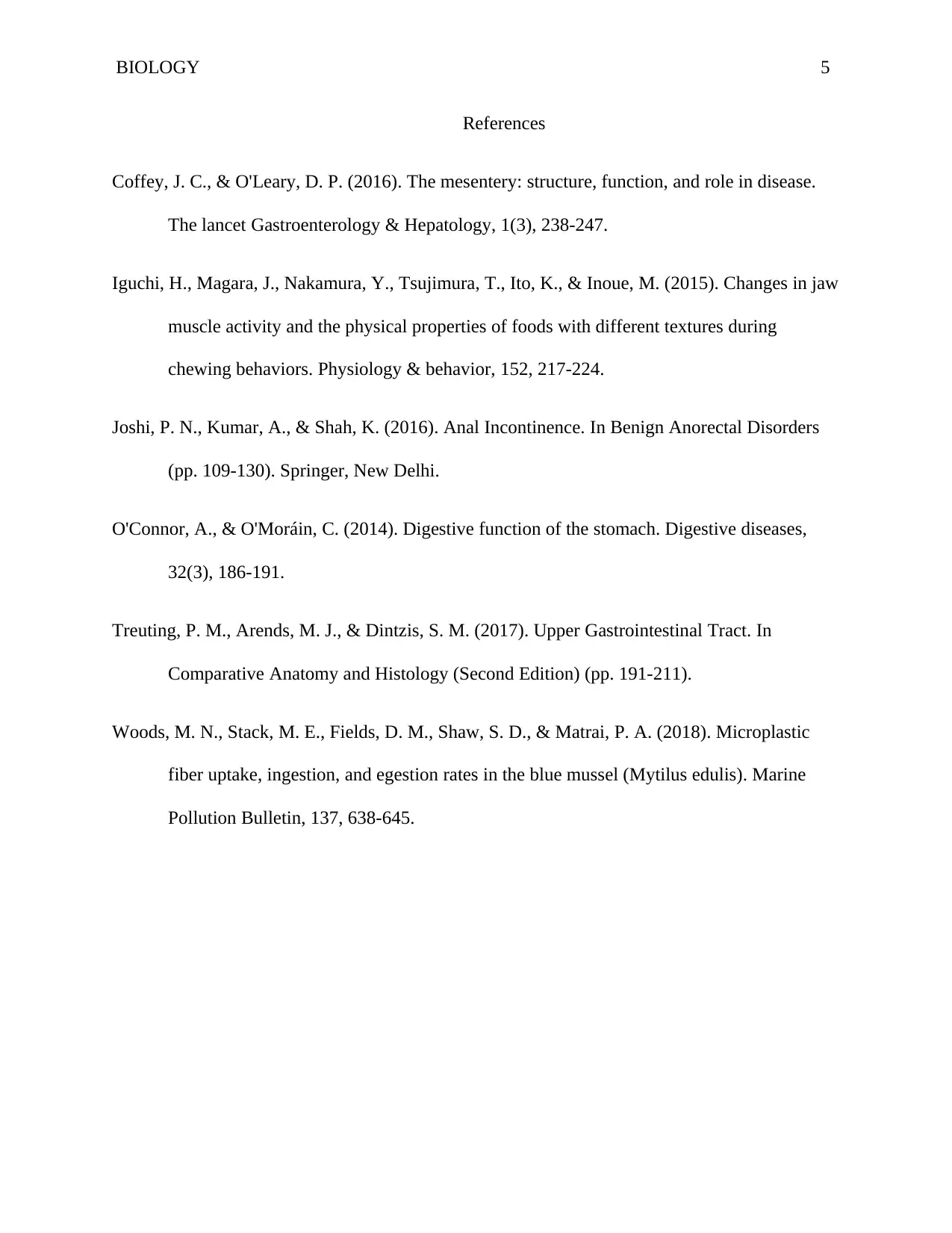Biology Assignment: Digestive System Structure & Functions
VerifiedAdded on 2023/05/29
|5
|1149
|152
Essay
AI Summary
This biology essay provides a detailed overview of the human digestive system. It begins with an introduction to the system's functions, including ingestion, digestion, absorption, assimilation, and egestion. The essay then explores the structure of each organ, such as the mouth, esophagus, stomach, small intestine, large intestine, and anus, and explains how these structures relate to their specific roles in the digestive process. For example, the essay discusses how the muscular structure of the stomach aids in digestion, and how the villi and microvilli in the small intestine increase the surface area for absorption. The essay concludes by summarizing the relationship between the organs and the digestive system's overall functions, highlighting the importance of each component in the breakdown and processing of food and the elimination of waste. References from scientific journals are included to support the information provided.

Running head: BIOLOGY 1
Biology
Student’s Name
Institutional Affiliation
Biology
Student’s Name
Institutional Affiliation
Paraphrase This Document
Need a fresh take? Get an instant paraphrase of this document with our AI Paraphraser

BIOLOGY 2
Introduction
The digestive system contains the gastrointestinal tract along with the accessory
digestive organs that operate together to chemically and mechanically digest food, absorb water
along with nutrients and eliminate wastes. Its functions include ingestion, digestion, absorption,
assimilation, and egestion. This essay explains how the structure of each organ of the digestive
system relates to these functions.
Ingestion is the consumption of substances through the mouth into the gastrointestinal
tract. The structures of the mouth which are muscles, mechanical and chemical action and moist
relate to ingestion (Iguchi et al., 2015). The cheeks make up the side walls of the mouth, and
their outer covering is skin while their inner coating is a mucous membrane. In between the skin
and the mucous membrane are connective tissues and buccinators muscles whereby these
muscles along with orbicularis oris muscle in the lips contract helping the food when being
chewed not to fall out of the mouth.
In the mouth, food is broken down by a crushing action by teeth into small pieces and
then moistened by saliva which is secreted by the parotid, sublingual and submaxillary glands
(Iguchi et al., 2015). The epiglottis averts food from entering the larynx at the upper part of the
respiratory system, and once the food is swallowed, it flows through the esophagus which is long
and by a series of muscular contractions known as peristalsis it reaches the stomach. In the
esophagus, there is no digestion that takes place.
Another function of the digestive system is digestion which occurs in the stomach
(O'Connor & O'Moráin, 2014). It is referred to as the breakdown of large insoluble food particles
into small water-soluble food particles so that they can be absorbed into the watery blood
Introduction
The digestive system contains the gastrointestinal tract along with the accessory
digestive organs that operate together to chemically and mechanically digest food, absorb water
along with nutrients and eliminate wastes. Its functions include ingestion, digestion, absorption,
assimilation, and egestion. This essay explains how the structure of each organ of the digestive
system relates to these functions.
Ingestion is the consumption of substances through the mouth into the gastrointestinal
tract. The structures of the mouth which are muscles, mechanical and chemical action and moist
relate to ingestion (Iguchi et al., 2015). The cheeks make up the side walls of the mouth, and
their outer covering is skin while their inner coating is a mucous membrane. In between the skin
and the mucous membrane are connective tissues and buccinators muscles whereby these
muscles along with orbicularis oris muscle in the lips contract helping the food when being
chewed not to fall out of the mouth.
In the mouth, food is broken down by a crushing action by teeth into small pieces and
then moistened by saliva which is secreted by the parotid, sublingual and submaxillary glands
(Iguchi et al., 2015). The epiglottis averts food from entering the larynx at the upper part of the
respiratory system, and once the food is swallowed, it flows through the esophagus which is long
and by a series of muscular contractions known as peristalsis it reaches the stomach. In the
esophagus, there is no digestion that takes place.
Another function of the digestive system is digestion which occurs in the stomach
(O'Connor & O'Moráin, 2014). It is referred to as the breakdown of large insoluble food particles
into small water-soluble food particles so that they can be absorbed into the watery blood

BIOLOGY 3
plasma. The stomach is very muscular, and it contains three regions which are the cardiac which
contain the cardiac glands which secrete mucus and the fundus region which contain the gastric
glands that produce gastric juices. The body of the stomach follows these regions, and is coated
with rugae which in turn assist in enhancing digestion by increasing the surface area of the site
(O'Connor & O'Moráin, 2014).
When the moistened and chewed food particles reach the stomach it is bathed with the
hydrochloric acid secreted by mucus since this sort of acidic environment is required for the food
substance to be digested by enzymes that need an acidic pH (O'Connor & O'Moráin, 2014).
Through the help of these enzymes, the large molecules are broken down into some small
molecules such as sugars, fatty acids, glycerol, and amino acids.
Absorption and assimilation occur in the small intestines. It is the process in which the
digested food materials get into cells or across the tissues and organs via osmosis or diffusion,
and it occurs in the small intestines. The small intestine is a long, convoluted tube-like organ and
has special cells which help in the absorption of nutrients from the intestinal lining into the
bloodstream (Treuting, Arends & Dintzis, 2017). Since the simple molecules such as alcohol and
water are already absorbed by the stomach, the complex molecules such as sugars, fatty acids
together with amino acids are absorbed by the walls of the small intestine.
The huge absorptive area of the small intestines is because of the mucosal folds, villi,
and microvilli (Treuting, Arends & Dintzis, 2017). The large microvilli surface generates a brush
border which increases the rate of absorption of nutrients to a great extent. After nutrients have
been absorbed, those in the bloodstream reach the tissues and cells which use them for their
activities like helping in the cell growth and development of new cell production.
plasma. The stomach is very muscular, and it contains three regions which are the cardiac which
contain the cardiac glands which secrete mucus and the fundus region which contain the gastric
glands that produce gastric juices. The body of the stomach follows these regions, and is coated
with rugae which in turn assist in enhancing digestion by increasing the surface area of the site
(O'Connor & O'Moráin, 2014).
When the moistened and chewed food particles reach the stomach it is bathed with the
hydrochloric acid secreted by mucus since this sort of acidic environment is required for the food
substance to be digested by enzymes that need an acidic pH (O'Connor & O'Moráin, 2014).
Through the help of these enzymes, the large molecules are broken down into some small
molecules such as sugars, fatty acids, glycerol, and amino acids.
Absorption and assimilation occur in the small intestines. It is the process in which the
digested food materials get into cells or across the tissues and organs via osmosis or diffusion,
and it occurs in the small intestines. The small intestine is a long, convoluted tube-like organ and
has special cells which help in the absorption of nutrients from the intestinal lining into the
bloodstream (Treuting, Arends & Dintzis, 2017). Since the simple molecules such as alcohol and
water are already absorbed by the stomach, the complex molecules such as sugars, fatty acids
together with amino acids are absorbed by the walls of the small intestine.
The huge absorptive area of the small intestines is because of the mucosal folds, villi,
and microvilli (Treuting, Arends & Dintzis, 2017). The large microvilli surface generates a brush
border which increases the rate of absorption of nutrients to a great extent. After nutrients have
been absorbed, those in the bloodstream reach the tissues and cells which use them for their
activities like helping in the cell growth and development of new cell production.
⊘ This is a preview!⊘
Do you want full access?
Subscribe today to unlock all pages.

Trusted by 1+ million students worldwide

BIOLOGY 4
The undigested and unabsorbed food heads to the large intestine which is wide and the
remaining water are reabsorbed together with vitamins (Coffey & O'Leary, 2016). These
undigested foods must be removed from the system through defecation since the buildup of such
substances in the large intestine is not healthy. Egestion is the process getting rid of the
undigested food which takes place at the end of the alimentary canal which is the anus (Woods,
Stack, Fields, Shaw & Matrai, 2018). Before egestion, the undigested food material is stored in
the rectum. The anal sphincter which is a muscular ring keeps the anus closed until there is a
need for a bowel movement or until egestion takes place (Joshi, Kumar & Shah, 2016).
Conclusion
The digestive system contains organs like the mouth, the esophagus, the stomach, the
small intestines, the large intestines, and the anus. As discussed, these organs have some features
which relate to the functions of the digestive system which are ingestion, digestion, absorption,
and assimilation along with egestion.
The undigested and unabsorbed food heads to the large intestine which is wide and the
remaining water are reabsorbed together with vitamins (Coffey & O'Leary, 2016). These
undigested foods must be removed from the system through defecation since the buildup of such
substances in the large intestine is not healthy. Egestion is the process getting rid of the
undigested food which takes place at the end of the alimentary canal which is the anus (Woods,
Stack, Fields, Shaw & Matrai, 2018). Before egestion, the undigested food material is stored in
the rectum. The anal sphincter which is a muscular ring keeps the anus closed until there is a
need for a bowel movement or until egestion takes place (Joshi, Kumar & Shah, 2016).
Conclusion
The digestive system contains organs like the mouth, the esophagus, the stomach, the
small intestines, the large intestines, and the anus. As discussed, these organs have some features
which relate to the functions of the digestive system which are ingestion, digestion, absorption,
and assimilation along with egestion.
Paraphrase This Document
Need a fresh take? Get an instant paraphrase of this document with our AI Paraphraser

BIOLOGY 5
References
Coffey, J. C., & O'Leary, D. P. (2016). The mesentery: structure, function, and role in disease.
The lancet Gastroenterology & Hepatology, 1(3), 238-247.
Iguchi, H., Magara, J., Nakamura, Y., Tsujimura, T., Ito, K., & Inoue, M. (2015). Changes in jaw
muscle activity and the physical properties of foods with different textures during
chewing behaviors. Physiology & behavior, 152, 217-224.
Joshi, P. N., Kumar, A., & Shah, K. (2016). Anal Incontinence. In Benign Anorectal Disorders
(pp. 109-130). Springer, New Delhi.
O'Connor, A., & O'Moráin, C. (2014). Digestive function of the stomach. Digestive diseases,
32(3), 186-191.
Treuting, P. M., Arends, M. J., & Dintzis, S. M. (2017). Upper Gastrointestinal Tract. In
Comparative Anatomy and Histology (Second Edition) (pp. 191-211).
Woods, M. N., Stack, M. E., Fields, D. M., Shaw, S. D., & Matrai, P. A. (2018). Microplastic
fiber uptake, ingestion, and egestion rates in the blue mussel (Mytilus edulis). Marine
Pollution Bulletin, 137, 638-645.
References
Coffey, J. C., & O'Leary, D. P. (2016). The mesentery: structure, function, and role in disease.
The lancet Gastroenterology & Hepatology, 1(3), 238-247.
Iguchi, H., Magara, J., Nakamura, Y., Tsujimura, T., Ito, K., & Inoue, M. (2015). Changes in jaw
muscle activity and the physical properties of foods with different textures during
chewing behaviors. Physiology & behavior, 152, 217-224.
Joshi, P. N., Kumar, A., & Shah, K. (2016). Anal Incontinence. In Benign Anorectal Disorders
(pp. 109-130). Springer, New Delhi.
O'Connor, A., & O'Moráin, C. (2014). Digestive function of the stomach. Digestive diseases,
32(3), 186-191.
Treuting, P. M., Arends, M. J., & Dintzis, S. M. (2017). Upper Gastrointestinal Tract. In
Comparative Anatomy and Histology (Second Edition) (pp. 191-211).
Woods, M. N., Stack, M. E., Fields, D. M., Shaw, S. D., & Matrai, P. A. (2018). Microplastic
fiber uptake, ingestion, and egestion rates in the blue mussel (Mytilus edulis). Marine
Pollution Bulletin, 137, 638-645.
1 out of 5
Related Documents
Your All-in-One AI-Powered Toolkit for Academic Success.
+13062052269
info@desklib.com
Available 24*7 on WhatsApp / Email
![[object Object]](/_next/static/media/star-bottom.7253800d.svg)
Unlock your academic potential
Copyright © 2020–2025 A2Z Services. All Rights Reserved. Developed and managed by ZUCOL.





